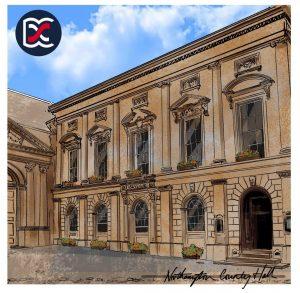County Hall, Northampton
The County Hall is another building that has not been forgotten although the history usually is.
In the aftermath of the great fire of 1675 when the majority of the town was destroyed, local people and businesses raised £25,000 towards re-building the town centre based around the Market Square. Streets were widened to help prevent a re-occurrence. King Charles II donated 1,000 tons of timber from Salcey Forest (hence why he is always remembered on Oak Apple Day) . Almost fifty years later, Daniel Defoe, the author of Robinson Crusoe, described Northampton as the “handsomest and best built town in all this part of England…..finely rebuilt with brick and stone, and the streets made spacious and wide“.
The ‘L’ shaped Sessions House and what is now County Hall were amongst the first buildings to be completed. The present County Hall was erected between 1676 and 1678 from the designs of Sir Roger Norwich, 2nd Baronet of Brampton in Northamptonshire, by Henry Jones, who designed the new All Saints’ Church. The Sessions House was built to provide a proper place to hold the County Assize Courts. It was also used for the Quarter Sessions, held four times a year, where local Justices of the Peace heard less serious cases and made decisions about a variety of administrative matters throughout Northamptonshire.
It is built in the Classic Renaissance style of the day, a simple single-story building, with a high-pitched hipped roof. The main front, facing north to George Row, is a well-balanced composition with a balustrade and curved pediment at each end containing the Royal Arms. Inside, the plasterwork on the ceiling which was created by Edward Goudge between 1684 and 1688 is simply stunning. In the centre is a cherub in the role of Lady Justice. In the one hand are the scales of justice depicting the weighing of evidence and in the other hand the sword depicting punishment for any that are found guilty. On the left-hand panel can be seen the angel to represent the honest and the innocent and on the other side, is the devil representing the dishonest and the guilty. Legend has it that if anyone in the dock told a lie then the devil would wag his tongue. According to one account, a mechanism that could make the tongue wag was discovered during renovation work in the roof space. Trials were considered excellent entertainment and judges in the 18th century had trouble controlling the “noisy, rude, curious, hardly restrainable low rabble forcing themselves into the court.”

County Hall as it is today. Note the faces above the windows – they are reputedly supposed to represent the four seasons. Also note the centre window which was the original doorway.

Representing the guilty and dishonest, this sinister plaster depiction of the devil had a tongue that would waggle if a defendant lied.
If you haven’t had a look inside, it is usually open on Heritage Weekends – go take a look. Be warned – the court itself has a strange feel about it, perhaps because so many people were sentenced to death there? Including witches. And did you know that the first recorded use of the ducking stool for witches in England was here in Northampton?
Mike Ingram MA, Historian, Author, and Freeman of the ancient borough of Northampton
Want to know more? Then please read Mike Ingram’s book, Northampton: 5,000 years of history.
Established in 2003, David Cosby are a firm of Chartered Surveyors and Professional Estate Agents. We have the benefit of surveying and legal expertise to help facilitate the smooth sale of your home. With successful sales throughout Northamptonshire, we have a proven track record which is supported by impressive Google reviews.
For a free market appraisal or further information on how we can assist in the sale of your home please visit our Estate Agency Home Page or call us on 01327 361664.
David Cosby Chartered Surveyors & Estate Agents


